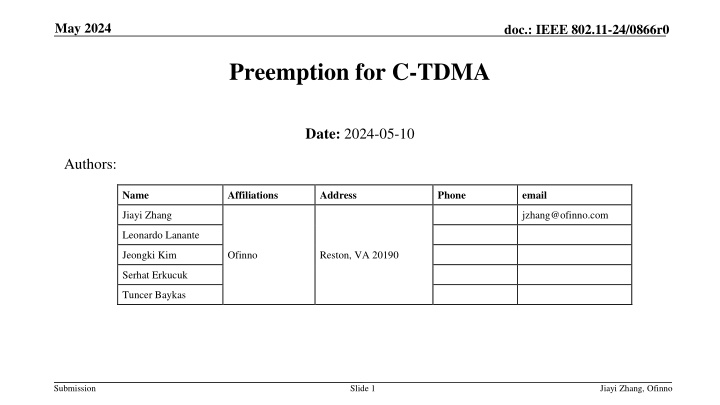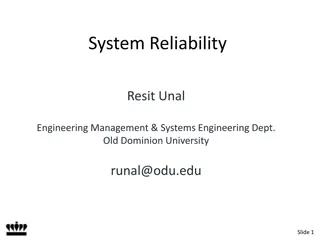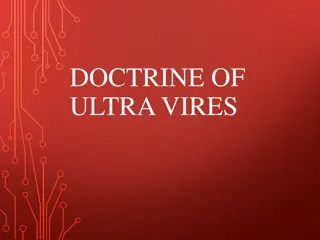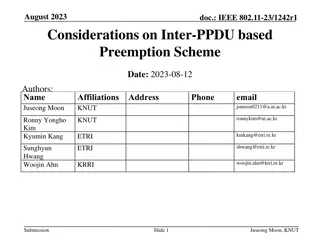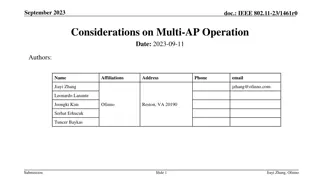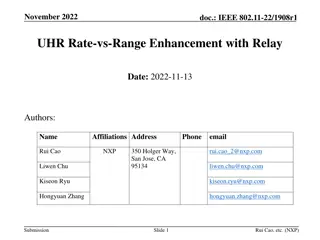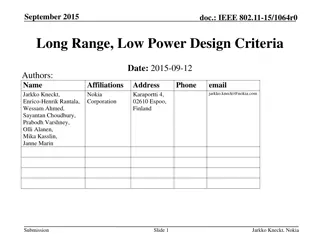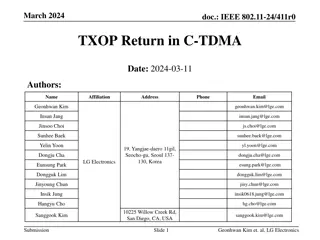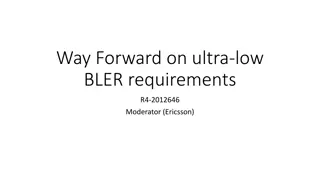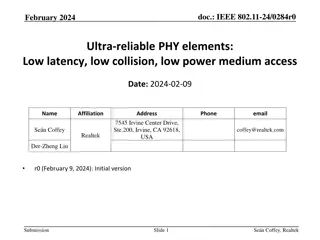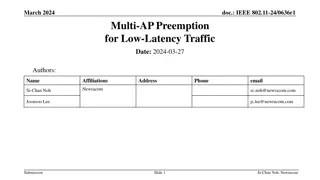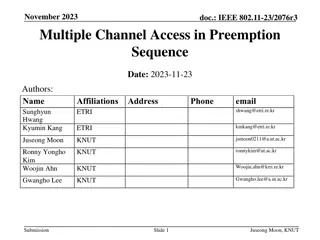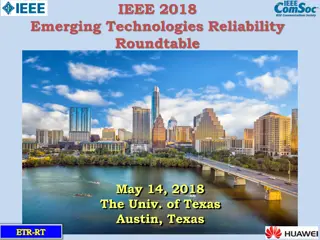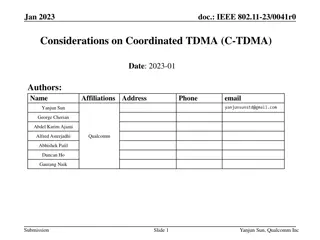Preemption Methods for Ultra High Reliability in Multi-AP C-TDMA
In this IEEE document, preemption methods are discussed for the coordinated time-division multiple-access (C-TDMA) scheme to enhance the Ultra High Reliability (UHR) capability in multi-AP operation. The focus is on reducing delays during large PPDU transmissions and improving coordination between sharing and shared APs. Various preemption techniques and their impact on low-latency traffic are explored within the context of C-TDMA implementation.
Download Presentation

Please find below an Image/Link to download the presentation.
The content on the website is provided AS IS for your information and personal use only. It may not be sold, licensed, or shared on other websites without obtaining consent from the author.If you encounter any issues during the download, it is possible that the publisher has removed the file from their server.
You are allowed to download the files provided on this website for personal or commercial use, subject to the condition that they are used lawfully. All files are the property of their respective owners.
The content on the website is provided AS IS for your information and personal use only. It may not be sold, licensed, or shared on other websites without obtaining consent from the author.
E N D
Presentation Transcript
May 2024 doc.: IEEE 802.11-24/0866r0 Preemption for C-TDMA Date: 2024-05-10 Authors: Name Affiliations Address Phone email Jiayi Zhang jzhang@ofinno.com Leonardo Lanante Jeongki Kim Ofinno Reston, VA 20190 Serhat Erkucuk Tuncer Baykas Submission Slide 1 Jiayi Zhang, Ofinno
May 2024 doc.: IEEE 802.11-24/0866r0 Abstract In PAR of P802.11bn, the Ultra High Reliability (UHR) capability has been defined to improve Rate-vs-Range enhancement, reduce latency, and reduce power consumption for AP, compared to Extremely High Throughput (EHT) MAC/PHY operation [1]. Coordinated time-division multiple-access (C-TDMA) has been discussed [2-8] as one of the candidate schemes of multi-AP operation (aka. Multi-AP coordination/transmission) to meet the requirement of UHR capability. Meanwhile, preemption have been proposed as a general solution to solve the problem of large delays when a large PPDU is transmitted in a TXOP [9-16]. In this contribution, we discuss some methods of preemption for C-TDMA. Submission Slide 2 Jiayi Zhang, Ofinno
May 2024 doc.: IEEE 802.11-24/0866r0 Background In C-TDMA, a sharing AP (e.g., AP1 ) that is TXOP owner coordinate with one or more shared APs (e.g., AP2 that is an OBSS AP) by sharing a portion of TXOP for use of transmission. MU-RTS triggered TXOP sharing (TXS) has been proposed for use in C-TDMA to allow the sharing AP to share an allocation duration of the TXOP to the shared AP. CF-end may be used by the shared AP to return the remaining allocation duration to the sharing AP. TXOP owned by AP 1 Allocation duration to AP 2 MRTT Data AP 1 BA STA 1 Shared TXOP used by AP 2 Shared TXOP returned to AP 1 CF- End CTS Data AP 2 BA STA 2 T1 T2 Submission Slide 3 Jiayi Zhang, Ofinno
May 2024 doc.: IEEE 802.11-24/0866r0 Low-Latency Traffic in C-TDMA In C-TDMA, the sharing AP (AP1) owns TXOP and shares a period of TXOP to the shared AP (AP2). When implementing preemption in C-TDMA, AP2 may allow preemption within its own BSS (e.g., allow AP2 or STA2 to preempt) the on-going transmission if necessary. However, when AP1 has a low latency(LL) traffic arriving during the period shared with AP2, AP2 doesn t allow AP1 to preempt. As a result, AP1 has to wait until the end of the shared period to send a data frame of LL traffic to STA1. TXOP of AP1 Period allocated to AP2 LL arrival delay Sharing AP (AP 1) MRTT LL Non-AP STA 1 Shared AP (AP 2) CTS Data Non-AP STA 2 BA Submission Slide 4 Jiayi Zhang, Ofinno
May 2024 doc.: IEEE 802.11-24/0866r0 Preemption for C-TDMA - Method 1 AP1 sends to AP2 an MU-RTS TXS trigger (MRTT) frame specifying an allocation duration and recommending, a preference of AP1 for the allowance of preemption within the allocation duration. The preemption is allowed by the AP1 only, and disallowed by a non-AP STA. After responding a CTS to MRTT, AP2 decides that whether allow preemption based on the preference. For example, AP2 allows the preemption: AP2 transmits short PPDUs and set preemption is allowed in the PPDU. AP2 doesn't allow the preemption: AP1 can not preempt (not shown). Duration allocated to AP2 Sharing AP (AP 1) LL Data MRTT +Preference PReq PRel Indicating a preference of preemption allowance Non-AP STA 1 BA Preemption allowed Preemption allowed Shared AP (AP 2) Data Data CTS Non-AP STA 2 BA Submission Slide 5 Jiayi Zhang, Ofinno
May 2024 doc.: IEEE 802.11-24/0866r0 Preemption for C-TDMA - Method 2 AP1 sends to AP2 a request frame requesting AP2 to allow preemption. The preemption is allowed by the AP1 only, and disallowed by a non-AP STA. AP2 decides that whether AP2 allows preemption or not, and responds to AP1. Based on the response of AP2, AP1 sends a MRTT to AP2 and decides the allocation duration to AP2. For example: If AP2 accepts the request, AP1 sets the allocation duration to be larger than a value and so that the allocation duration is sufficiently long for AP2 to participate in C- TDMA with preemption. If AP2 rejects the request, AP1 sets the allocation duration to be shorter than the value (not shown). TXOP owned by AP1 Duration allocated to AP2 based on response (accept) of preemption allowance Sharing AP (AP 1) LL Data Req MRTT PReq PRel Requesting a preemption Response (accept) allowance Non-AP STA 1 BA Preemption is allowed based on response Shared AP (AP 2) Data Data CTS Rsp Non-AP STA 2 BA Submission Slide 6 Jiayi Zhang, Ofinno
May 2024 doc.: IEEE 802.11-24/0866r0 Summary In this contribution, we shared some thoughts of preemption for C-TDMA. MRTT with a preference/recommendation of preemption allowance A request/response of preemption allowance frame exchange before MRTT Submission Slide 7 Jiayi Zhang, Ofinno
May 2024 doc.: IEEE 802.11-24/0866r0 References 1. 23/0480, UHR proposed PAR, Laurent Cariou (Intel) 2. 23/0041, Yanjun Sun (Qualcomm), Considerations on Coordinated TDMA (C-TDMA), 2023-01 3. 23/0261, Dibakar Das (Intel), C-TDMA procedure in UHR, 2023-01-25 4. 23/0739r1, Yanjun Sun (Qualcomm), Follow-up on Coordinated TDMA (C-TDMA), 2023-05-15 5. 23/1085, Geonhwan Kim (LG Electronics), Thoughts on Coordinated TDMA, 2023-08-07 6. 23/1327, Si-Chan Noh (Newracom), Considerations on Return TXOP between multiple APs, 2023-08-07 7. 24/0382, Serhat Erkucuk (Ofinno), Further Considerations on Coordinated TDMA, 2024-02-28 8. 24/0512, Rubayet Shafin (Samsung Electronics), Considerations for Coordinated TDMA, 2024-04-28 9. 23/1229r1, Juan Feng (Intel), Preemption for Low Latency Application, 2023-08-10, (23/0092, follow up, 2023-03-13) 10. 22/0018r1, Kiseon Ryu (NXP), Low Latency Support in UHR, 2023-02-05, (23/1174, follow up, 2023-07-06) 11. 23/1886, Giovanni Chisci (Qualcomm), Preemption techniques to meet low-latency (LL) targets, 2024-01-10 12. 23/1950, Leonardo Lanante (Ofinno), Considerations on Preemption Request, 2023-11-13 13. 24/0131, Insun Jang (LG Electronics), Signaling of Preemption, 2024-03-11 14. 24/0389, Mohamed Abouelseoud (Apple), Preemption for Low Latency, 2024-04-10 15. 24/0390, Yunbo Li (Huawei), A Uniform Procedure for Preemption, 2024-02-08 16. 24/0391, Yunbo Li (Huawei), Legacy STA and OBSS Issues for Preemption, 2024-02-18 Submission Slide 8 Jiayi Zhang, Ofinno
